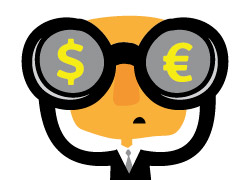Trade What You ‘See’, Not What You Think, Here-Say Is Heresy To FX Traders..
Most traders are familiar with the phrase “trade what you see not what you think”, it’s of particular relevance to technical chart traders who wait for market sentiment and the reaction to news events to eventually ‘bleed’ onto charts. However, like many throw away one liners, (that eventually and conveniently become attached to trading), it’s worth closer inspection to understand how this phrase and subliminal instruction can impact on our decision making and profitability..
From time to time, after major news events have moved the market, look at your charts and ask yourself, “if I’d been in a locked room totally isolated from any news, deprived of any intel, whether or not the decisions I’ve made would have been any different?” For example, despite all the market turmoil over the past two weeks the market for the EUR/USD has ‘behaved’ no more randomly than other weeks. If you’d switched off all media contact; print, internet, squawk and been unaware of the turmoil, would your performance and decision making have changed radically? If you’d traded what you saw not what you thought would happen, due to an assimilation of all your intelligence gathering, would you have performed any better?
Whether you’re a scalper, intraday trader or trend trader the news is highly important to you trading plan, however, news trading can be very difficult to apply without access to state of the art equipment and vast experience of market exposure. Let’s not forget a real gem of a phrase in relation to news trading, “don’t trade the news, trade the reaction to the news”, reaction that will eventually display on you charts.
So what should you ‘see’ in order to trade and what should you dismiss as ‘here say’?
The daily volume of opinion offered up for debate, on any given economic subject, is staggering. The variety of comment provided, by totally convincing and convicted market commentators, is breath-taking. Particularly in the area of ‘sit on the fence’ commentary where commentators with total conviction will give you their either or scenarios as fact; “it may rain today, but looking at the long term forecast it could get sunnier” could adequately sum up the contribution of many.
By the time you’ve digested; Bloomberg news, Reuters, perhaps the FT and your preferred newspaper, (online or in print), together with the radio and or tv news bulletins you’ll have been bombarded with thousands of words forming opinions as to what the markets will (or may) do today, tomorrow, this week.. And the resulting combined opinion of the gathering of; sages, economists, commentators, famed investors, politicians often leaves us punch drunk with opinion. If you were to dump all that opinion into a blender you’d find the end product as stale, bitter, barely nutritious and as out of date as the taste of an over ripe banana milk shake, made to rid yourself of the old lurking bananas before they ‘go off’..
So how do you marry fundamental news with chart trading and can you combine both, if so how? Well the short answer is yes, you absolutely have to be aware of market data and how that will translate into market sentiment. Traders simply have to be aware of news events and how they’re likely to move the market.
One of the continual (and free) feeds each trader must have access to is a daily economic calendar, use it. It’s essential to have interest and intellectual curiosity of your industry beyond the simple mechanics of charting. You need to know why and how price reacts the way it does. Whilst price may react to the levels on charts, those levels are dictated by and created due to the translation of the fundamental economic data delivered by govts, institutions and states. As traders it’s essential that you ignore opinion and only concentrate on the facts, ignoring the hindsight translation of those facts which can lead to uncertainly and indecision. Pointing out the jagged bump in the road or hazard that causes our flat tyre is irrelevant.
There are two sets of facts we can have absolute confidence in. Firstly, even if you doubt the methodology employed in gathering certain data, for example how the BLS collect their USA job data, you can have absolute conviction that the market will not initially micro analyse the fresh numbers, the market will react to the hard data on publication. Secondly the other hard data we can have absolute confidence in is the mathematical purity of charts and how charts translate the data.
There is an obvious reason many experienced traders, even if confirmed chartists, will pay up to €2000 for a Bloomberg terminal and several hundred for a squawk each month, they pay for it because it ‘works’ for them and aids profitability. Experience has proven that undeniably fundamental macro events move the market, not what levels an indicator reaches on a chart. The chart provides a graphical representation of sentiment and displays that graphical representation based on past performance of how long current sentiment may continue.
Always trade what you see but never stop thinking or listening, but listen to opinion and commentary without basing trading decisions on it. Base your decisions on one opinion, your own, reached through a combination of experience of macro news events and data and how that data translates onto your charts. How you interpret graphic representation is a different skill, a skill that can only be put to use whilst being tuned into and aware of the bigger picture.






Comments are closed.